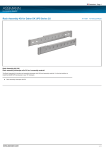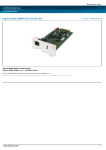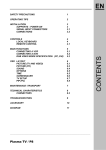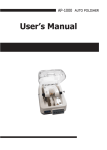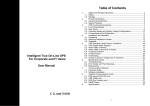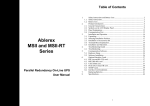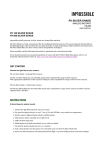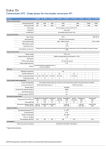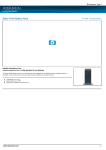Download Daker DK 4.5, 6, 10 kVA
Transcript
® Daker DK 4.5, 6, 10 kVA Manuel d’installation • Installation manual Part. LE05380AC-07/13-01 GF Daker DK 4.5, 6, 10 kVA 1 Introduction 26 2 Conditions of use 26 3 LCD Panel 27 4 Rear panel 29 5 Installation 31 6 UPS communicator self-diagnostic software 42 7 Possible malfunctioning 42 8 Technical features 43 25 EN Index ® 1 Introduction This manual contains information for users of the Daker DK 4.5, 6, 10 kVA models. You are advised to read this handbook carefully before installing your uninterruptible power supply, meticulously following the instructions given herein. The UPS Daker DK is only been made for civil or industrial use; it is not in conformity with the standards for electro-medical equipment. In case of problems with the UPS, please read this manual before contacting technical support; The “Troubleshooting” section can in fact help resolving most of the problems encountered while using the uninterruptible power supply. 2 Conditions of use • The UPS has been designed for the power supply of the data processing equipment; The load applied must not exceed the one indicated on the rear label of your UPS. • The ON/OFF button of your UPS does not electrically isolate the internal parts. To isolate your UPS unplug it from the mains power socket. • Do not open the UPS container since there may be parts inside with dangerously high voltage even when the mains plug is disconnected; there are no parts inside that the user can repair. • The front control panel is provided for manual operations; Do not press on the panel with sharp or pointed objects. • The UPS Daker DK has been designed to work in closed, clean rooms where there are no inflammable liquids or corrosive substances and where it is not too damp. • Do not place near equipments that generate strong electro-magnetic fields and/or near equipments that are sensible to electro-magnetic fields. (engines, floppy disks, speakers, adapters, monitors, video, etc...) • Do not pour any liquid on the UPS or inside the UPS. • Do not place the UPS in humid environment or near liquid, such as water, chemical solution… • Do not expose the UPS to the direct sunlight or any heat sorces. • Keep the ventilation slits clean to dissipate the heat of the UPS. • Use grounded power cable to connect the UPS to the mains supply. • Do not plug laser printers into the UPS because of their high start-up current. • Do not plug house electric equipments, such as hair dryer,air conditioner, and refrigerator into the UPS outlets. 26 Daker DK 4.5, 6, 10 kVA 3 LCD Panel 3 4 2 11 12 EN 1 5 9 10 8 6 7 1. LCD panel 2. Green LED indicates that the UPS is able to run under redundancy mode. 3. Solid green LED indicates that the utility input voltage is within the window. Flashing green LED indicates that the utility input voltage is within the acceptable window. 4. Green LED indicates that Bypass Input is normal. 5. UPS ON/Alarm Silence 6. Go to previous page or change the setting of the UPS. 7. Confirm a changed setting. 8. Go to the next page. 9. UPS OFF Switch 10. Special functions log in/out 11. UPS is working under ECO (Economical) mode. 12. UPS alarm LED 27 ® EPO Er05 Display LCD symbols Item Symbol Er06 Utility or Bypass Source 17 Er10 Inverter Over-current 2 Battery Low 18 Er11 The UPS is overheated 3 Battery Abnormal 19 Er12 UPS Output Overloading 4 UPS Overloading 20 Er14 Fan Error 5 UPS Working in specified mode* 21 Er15 Wrong Procedure to Enter Maintenance Mode 6 A Blackout Transfer occurred in UPS Output 22 Er28 Bypass Overload Time out 7 Bypass Input Abnormal, UPS fails to transfer to bypass 23 Er** Other Error code 8 Utility Input Abnormal Item Symbol 1 LINE 9 10 OFF Description UPS Shutoff LINE OFF UPS Abnormal Lock 11 UPS Flow Chart 12 4-Digit Measurement Display 13 Indicates the item to be measured 14 EPO Emergency Power Off 15 Er05 Battery Weak or Dead 16 Er06 Output Short Circuit Er10 28 3 LCD Panel Er11 Description Daker DK 4.5, 6, 10 kVA 4 Rear panel 14 19 15 RS232 13 EPO Ext. Battery G2 N22 G1 N1 3 100 56 3 100 57 L12 G + CB1 Utility Input Breaker 16 20 17-18 20 17-18 16 19 Ext. Battery - UTILITY INPUT BREAKER EPO G + 14 3 100 58 3 100 59 CH B SLOT S1 RS232 BYPASS INPUT BREAKER Not Intended to TNV Communication Network ON OFF US 6906501, TW 202668 19 20 13 3 100 53 3 100 54 PAT. NO.: G1 INPUT N1 L12 14 OUTPUT G2 N22 L21 Utility Input Breaker EPO Slot 15 L21-N22: UPS OUTPUT L12-N1: UTILITY INPUT G2: OUTPUT EARTH G1: INPUT EARTH GROUND GROUND Parallel Work Comm. Bus Not Intended to TNV Communication Network RS232 13 INPUT L21 - EN Parallel Work Comm. Bus Not Intended to TNV Communication Network OUTPUT OFF S1 ON TB1 15 TB2 17-18 13. RS-232 Port 17. AC utility power connection 14. E mergency Power Off (EPO) Dry Contact Signal inputs 18. AC Outlets power connection 15. Communication Card Options Slot 20. Cooling Fans 16. External Battery Connector 19. Utility Input circuit breaker 29 ® 4 Rear panel Interface Settings 3 100 53/54/55/56/57 OUTPUT G2 N22 L21 G1 INPUT N1 L12 L21-N22: UPS OUTPUT L12-N1: UTILITY INPUT G2: OUTPUT EARTH G1: INPUT EARTH GROUND GROUND 3 100 58 3 100 59 TB1 TB1 TB2 TB2 TB1 OUTPUT TB2 INPUT G2 G1 N1 N22 L21 UTILITY BYPASS L12 L11 DIM ONLY TB1 OUTPUT G1 G2 N22 L21 TB2 INPUT N1 T S R L11-N1 : clamps not used in this version L12-N1 : clamps for connection to the UPS input line (3 100 58) R-S-T-N1 : clamps for connection to the UPS input line (3 100 59) G1: clamp for UPS input ground cable connection L21-N22: clamps for UPS output connection G2: 30 clamp for UPS output ground cable connection Daker DK 4.5, 6, 10 kVA 5 Installation Check for the following standard package contents: • User Manual • RS-232 communication cable • Tower/Rack Accessories Kit as below: 3 100 53/54/56/57 A5 A6 A7 EN A4 x1 x1 x2 x2 3 100 58/59 A8 A9 x1 A10 x1 x2 A7 x2 B4 A1 B3 B1 B2 x4 A3 x2 x2 2U x2 3U x2 4U x1 S1 6.0 ±1.0mm M3 3 100 53/54/56/57 x8 3 100 58 x7 S2 6.0 ±1.0mm S3 8.0 ±1.0mm M3 M4 x8 x6 31 ® 5 Installation Tower configuration setup Step 1 A1 A1 A1 A1 Step 2 Optional 32 Daker DK 4.5, 6, 10 kVA UPS + battery cabinet EN Step 1 Step 2 A4 33 ® 5 Installation Configuration rack 19” Step 1 B1 S3 Step 2 Step 3 90° Step 4 34 B2 Daker DK 4.5, 6, 10 kVA EN Step 5 Step 6 35 ® 5 Installation On the rear of the uninterruptible power supply are the following connections: • Output sockets and input connector (17) or (18): connect to these connectors the power cable and the output cables included. • Socket for connecting computer serial interface RS232 (9 female pins) [4]: required when using the diagnostic and shutdown management software. • Presetting for the connection of additional batteries [16]. 3 100 53/54/56/57 A7 S1 A6 S1 A5 A4 S1 60 - 70 3 100 58/59 A7 S1 S1 A9 A10 A8 S1 Cable section table a. AC input and output (minimum 75°C copper wire) Model Maximum Current Conductor Section Torque 3 100 53/56 25 A 2 AWG #10/4 mm 17.7/ 11 lb-in 3 100 54/57 33 A 2 AWG # 8/6 mm 17.7/ 11 lb-in 3 100 58/59 54.3 A AWG # 6/10 mm2 23 lb-in b. Entrée Batterie 36 Model Maximum Current Conductor Section 3 100 53/56 19 A AWG #10/4 mm2 3 100 54/57 25 A AWG #10/4 mm2 3 100 58/59 41 A AWG #10/4 mm2 Daker DK 4.5, 6, 10 kVA WARNING For safety reasons it is advised not to modify the cables supplied; it is also necessary to make sure that the mains socket the uninterruptible power supply is connected to is fitted with a safe connection to the earth system, and appropriate protection in accordance with current regulations. WARNING The mains supply socket, or the disconnection device, must be installed nearby the equipment, and must be easily accessible. Proceed to the installation as follows: 1) Position the uninterruptible power supply so that the vents are not obstructed. 2) Connect the input connector [17] or [18], the power cable, and the output cables to the appropriate connectors [17] or [18]. 3) Connect the loads to the output cables, ensuring that the switches of the various users are off. 4) Connect the power supply plug to a power socket with suitable voltage and current. Start 1) Switch on the power breaker [19] of the distribution panel. Then the UPS will start up. Green , and show that the Utility and Bypass inputs are normal. The LCD will display LEDs OFF after few seconds. 2) The UPS is in Bypass Mode now. It will proceed to self-test automatically. If no abnormal message appears then the pre-startup of the UPS was successful and the charger starts to charge the batteries. 3) Press the UPS On Switch [5] for approximately three seconds. The Buzzer sounds twice and the LCD display changes from previous status to RUN mode. 4) The UPS is in self-test mode again. The LCD display will show TEST and the UPS will remain in battery mode for approximately four seconds. 5) If the self-test fails an error code or error status will appear on the screen. 6) Your start-up operation of the UPS is complete now. Make sure the UPS is plugged into the wall receptacle for charging at least 8 hours and the batteries are fully charged before connecting the device to be protected. Shutdown 7) Press the Off [9] key for five seconds. The Inverter output will be turned off, and the output load will be supplied by the Bypass loop. 8) Turn Off the Input breakers [19]. 9) The UPS is now turned off completely. 37 EN ® 5 Installation Default data and special function execution After the UPS completely starts up, press the key to change the LCD display to figure Q1. Q1 buzzer “On” Q2 buzzer “Off” Press the key to scroll through the UPS settings. The LCD will display in sequence figure Q1 (buzzer) figure R1 (Self-test) figure S1 (Bypass Voltage Windows) figure T (Output Frequency Synchronization Window) figure U (Inverter Output Voltage) figure V1 (UPS Operation Mode) figure W (Output Voltage Micro Tune Value) figure X (UPS Id) figure Y (Parallel function status). R1 Self-test disable R2 Self-test anable S1 Bypass Voltage is adjusted to narrow range S2 Bypass Voltage is adjusted to wide range T Frequency Window is +/-3 Hz 38 Daker DK 4.5, 6, 10 kVA U inverter output voltage EN V1 The UPS is operating in “normal mode” V2 The UPS is operating in “Eco mode” V3 The UPS is operating in “CVCF 50 Hz mode” V4 The UPS is operating in “CVCF 60 Hz mode” W Output Voltage Adjustment (-3% to 3%) X UPS position in parallel mode Y The parallel function is disabled 39 ® 5 Installation Press the scroll up key to execute special functions. The functions include buzzer ON (as in figure Q1), buzzer OFF (as in figure Q2, Alarm silence for UPS Warning), and self-test OFF (as in figure R1) or self-test ON (as in figure R2). The UPS will execute the battery test for ten seconds. If the self-test is successful it will display figure E1; otherwise, it will display figure E2 and an error message at the same time.) UPS Default Settings and their alternatives Make sure the UPS is not “On”. Press the On and scroll down keys simultaneously for approximately three seconds. The buzzer will sound twice, and the LCD will display figure Q1, indicating that the UPS is in setting mode. To scroll through the options press the key to go DOWN and to scroll up. Except for Buzzer (figures Q1 and Q2) and Self-test (figures R1 and R2) all of the other default settings may be changed by pressing the scroll up key. Figures S1 and S2 indicate the bypass input acceptable window. It can be 184-260 VAC or 195-260 VAC. Figure T indicates the bypass frequency window of the Inverter Output. The acceptable setting values are ±3 Hz and ±1 Hz. Figure U indicates the acceptable Inverter Output Voltage. Possible values are 200, 208, 220, 230, or 240 VAC. Figures V1, V2, V3 and V4 indicate the operation modes of the UPS. Possible values are Online, Eco (Economical) mode, fixed 50 Hz Output, and fixed 60 Hz Output. Figure W indicates the adjustment of the Inverter Output, which may be set to 0%, +1%, -1%, +2%, -2%, +3%, or -3%. Figure X indicates the position of the UPS when the UPS is in Parallel mode. Possible positions are 1, 2, 3, and 4. The position must be 1 if the UPS is not in Parallel mode. Figure Y indicates the parallel function status. “P 01” indicates that the parallel function is disabled, and “P 02” indicates that the parallel function is enabled. 40 Daker DK 4.5, 6, 10 kVA After changing settings you must scroll to the “save” screen (figure Z) and then press the enter key to save all of your changes. Then the LCD will display figure AA to indicate completion of the setting changes. To cancel your changes rather than save them press and hold the “OFF” key for five seconds. The LCD displays figure AA directly, which indicates that your changes were canceled. EN Z * Press the Enter key to save changes. AA The UPS is locked. Turn Off the Utility Input breaker. Your setting changes are now complete. Connection The UPS has an RS232 serial communication interface that provide access, through a processor, to a range of data for the operation and the history of the UPS. This function can be accessed through a WINDOWS (*) interfacing program, connecting a serial port of the PC to the interface socket that can be found on the back of the UPS using an RS232 cable. 41 ® 6 UPS communicator self-diagnostic software From the website www.ups.legrand.com it is possible to download free of charge a self-diagnostic software running on WINDOWS (16 e 32 bit) e Linux platforms. This software can be used for the following functions: - Display of all the operation and diagnostic data in case of problems. - Setup of special functions. - Automatic shutdown of the local computer (Windows and Linux operating systems). * Windows is a registered trademark of Microsoft Corporation. 7 Possible malfunctioning The UPS always operates on batteries: • There is no line voltage • Line voltage is out of allowed UPS range • The power supply cable is not correctly connected to mains socket. • The input circuit breaker has to be reset • The mains socket is defective The UPS signals overloading: • Additional loads to the ones normally connected have involuntarily been connected on the output line. • Check all the loads connected to the output The UPS doesn’t operate in battery mode (it shuts down or immediately signals it is close to the operating limit): • The UPS has operated with no mains voltage for a long time and has not been able to recharge the battery. Recharge it for at least 6 hours by connecting the uninterruptible power supply to the mains. • The battery is flat due to not using the UPS for a long period. Recharge it for at least 6 hours by connecting the uninterruptible power supply to the mains. • The battery has run down due to being used frequently, to ambient conditions, or to having exceeded its average service life; it is necessary to change it. The UPS doesn’t deliver power to the output: • Check that the loads are correctly connected to the output sockets 42 Daker DK 4.5, 6, 10 kVA Construction Specifications Weights Dimensions L x H x P in mm Protection 3 100 53 3 100 54 52 Kg 52 Kg 440 x 176 x 680 440 x 176 x 680 Electronic protection against overloading and short-circuiting. Shutdown on reaching operating limit and overheating. Automatic shutdown due to protection triggering Ambient specifications Operating temperature range Operating relative humidity range from 0 to +40 °C from 20 to 80% non-condensing Degree of protection as per IEC529 IP21 Noise level at 1 meter < 50 dBA Electrical input specifications Rated input voltage 230 V Range of input voltage from 160 V to 280 V Rated input frequency 50 or 60 Hz ± 5Hz Maximum input current 25 Arms Number of input phases 33 Arms Single phase Waveform on output With battery operation Type of operation sinusoidal on line - double conversion Electrical specifications on output Rated output voltage 230 V ± 2% Active output capacity on nominal load 4050W 5.4KW Apparent output capacity on nominal load 4.5KVA 6KVA Overload capacity Number of phases on output 105% continuous 120% for 30 seconds 140% for 10 seconds Single phase 43 EN 8 Technical features ® 8 Technical features Construction Specifications 3 100 53 3 100 54 Electrical specifications on output with battery operation Rated output voltage Output frequency 230 V ± 2% 50/60 Hz ± 0.5% Active output capacity on non-linear load 4.05kW 5.4kW Apparent output capacity on non-linear load 4.5kVA 6kVA 6 min. 4 min. Battery operation Operating time Charging time to 90% of the load Technical data and number of batteries 4 hours n°20 maintenance- free, sealed, lead battery 12V 5Ah n°20 maintenance-free, sealed, lead battery 12V 5Ah Standards Electromagnetic compatibility Emission - Immunity Conforms to EN 62040 - 2 Safety Conforms to EN 62040 -1 Performance and features Conforms to EN 62040 -3 NOTICE The batteries are considered hazardous waste and should be disposed of in accordance with current regulations. 44 Daker DK 4.5, 6, 10 kVA Weights Dimensions L x H x P in mm Protection 3 100 56 3 100 57 25 Kg 25 Kg 3 100 58 3 100 59 26 Kg 440 x 88 x 680 440 x 88 x 680 440 x 132 x 680 Electronic protection against overloading and short-circuiting. Shutdown on reaching operating limit and overheating. Automatic shutdown due to protection triggering EN Construction Specifications Ambient specifications Operating temperature range from 0 to +40 °C Operating relative humidity range from 20 to 80% non-condensing Degree of protection as per IEC529 IP21 Noise level at 1 meter < 50 dBA Electrical input specifications Rated input voltage Range of input voltage Rated input frequency Maximum input current 230 V 380 V from 160 V to 280V from 227V to 485V 50 or 60 Hz ± 5Hz 25 Arms Number of input phases 33 Arms 54,3 Arms Single phase Waveform on output With battery operation sinusoidal Type of operation on line - double conversion Electrical specifications on output Rated output voltage 230 V ± 2% Active output capacity on nominal load 4.05kW 5.4 kW 9 kW Apparent output capacity on nominal load 4.5kVA 6 KWA 10 KWA Overload capacity Number of phases on output 105% continuous 120% for 30 seconds 140% for 10 seconds Single phase Three phase 45 ® 8 Technical features Construction Specifications 3 100 56 3 100 57 3 100 58 3 100 59 Electrical specifications on output with battery operation Rated output voltage 230 V ± 2% Output frequency 50/60 Hz ± 0.5% Active output capacity on non-linear load 4.05kW 5.4kW 9kW Apparent output capacity on non-linear load 4.5kVA 6kVA 10kW Charging time to 90% of the load 4 hours 5 hours Standards Electromagnetic compatibility Emission - Immunity Conforms to EN 62040 - 2 Safety Conforms to EN 62040 -1 Performance and features Conforms to EN 62040 -3 NOTICE The batteries are considered hazardous waste and should be disposed of in accordance with current regulations. 46
























